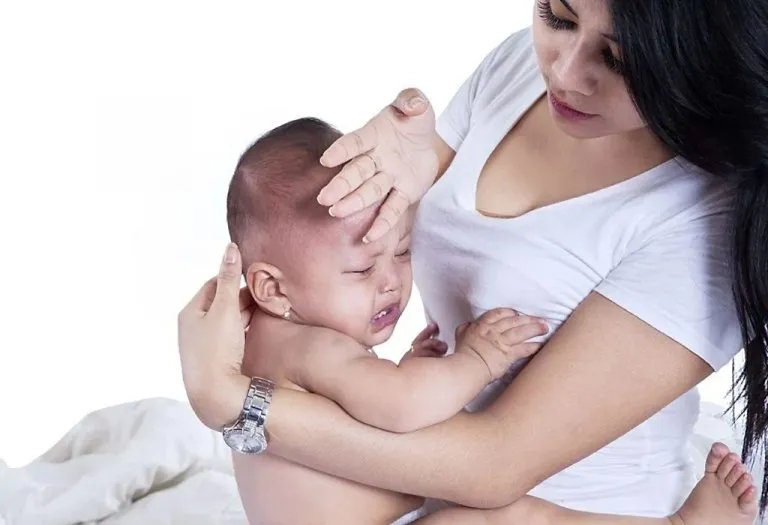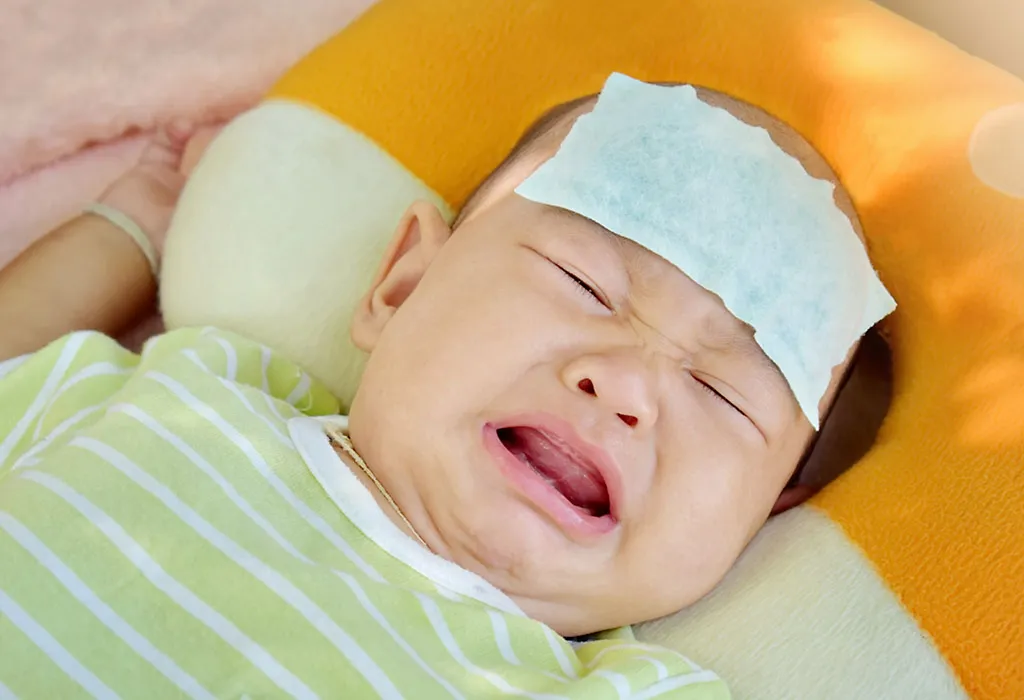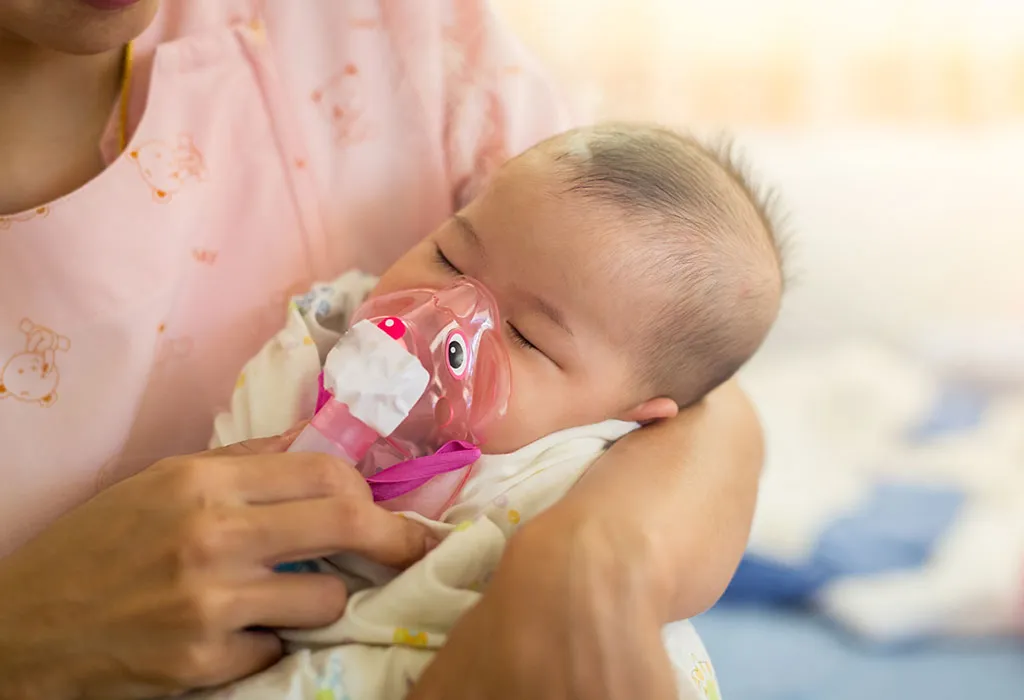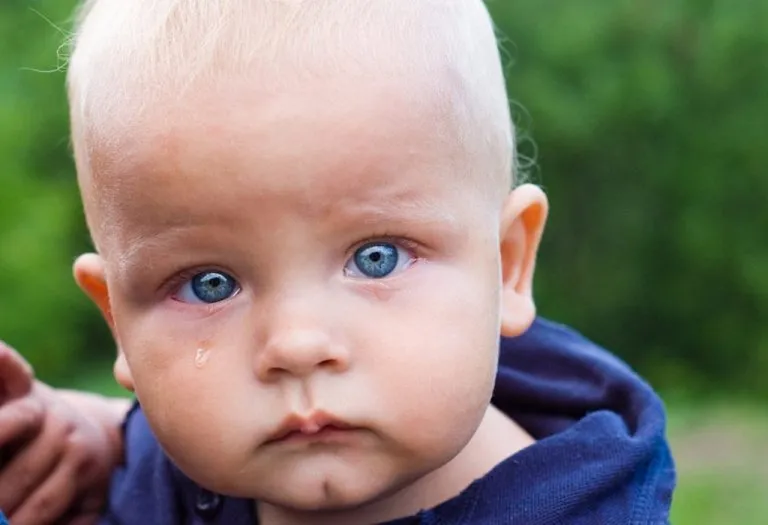Typhoid Fever in Babies & Toddlers – Causes, Symptoms, & Treatment

A newborn’s immune system is still developing, which makes them more likely to catch infections. Typhoid is one of these infections. It’s caused by the Salmonella typhi bacteria and can cause diarrheoa, fever, and vomiting. Without proper treatment, it can be very dangerous, especially for little ones. Typhoid in babies and toddlers is especially serious because their immune systems aren’t strong enough to fight off the bacteria easily. In this article, we will talk about typhoid in babies, including its symptoms, causes, how to treat it, and how to prevent it. Understanding these aspects is key to keeping young children safe and healthy.
What Is Typhoid?
Typhoid is a bacterial infection caused by the Salmonella Typhi (S. Typhi) bacteria, from the family Salmonella (causes food poisoning), which causes typhoid fever. The bacteria live in humans and is shed through a person’s urine or faeces. When the bacteria enters the body, it multiplies quickly and spreads into the body’s bloodstream. Typhoid fever in children can be caused due to negligent care and exposure to infected food and water. The symptoms seen are mild to severe and can disappear within 5 days after the treatment has begun. After recovery, your child could become a carrier of the bacteria, which means he can pass the disease to other people (1).
How Common Is Typhoid Fever in Babies and Toddlers?
Typhoid fever is more common among children, especially in developing and underdeveloped countries where access to clean water and proper sanitation is limited. It is particularly widespread in regions like the Indian subcontinent, South and Southeast Asia, Africa, and parts of South America. Among these, the Indian subcontinent reports the highest incidence, although the exact number of cases is unclear due to underreporting and limited diagnostic resources. Young children, including babies and toddlers, are at greater risk in these areas due to their weaker immunity and increased exposure to unsafe food and water.
Causes of Typhoid in Babies & Toddlers
The Salmonella Typhi bacteria attacks the central circulatory system and starts to multiply. Typhoid is an extremely infectious disease, which spreads fast and can be caused by these major reasons (1) (2):
- Food and water: Like cholera, typhoid is mainly transmitted through contaminated food and water. Babies contract the disease by consuming contaminated food or water.
- Carrier: A baby may become infected when a carrier or an infected person touches him/her without washing their hands.
- Food preparation: Unhygienic meals or improper storage also leads to typhoid in babies.
- Stools: The typhoid bacteria are passed in the stools of the infected person and not washing hands after going to the toilet can lead to an infection.
- Contact with infected surfaces: Babies and toddlers are likely to put things in their mouths. If they touch surfaces contaminated with the typhoid bacteria and then put their hands or toys in their mouths, they can become infected.
- Flies and pests: Flies can transfer the typhoid bacteria from contaminated faeces or food to areas where babies eat or play, increasing the risk of infection.
While typhoid is common in children between the ages of two and five, toddlers and babies can also easily contract it. The symptoms seen in toddlers and babies can easily be confused with other illnesses. It is uncommon for solely breastfed babies to get infected as they gain immunity through their mother’s milk and are protected against contaminated food as they don’t consume it.
What Are the Symptoms of Typhoid in Babies & Toddlers?
The symptoms of typhoid in babies develop within a week or two after the baby has come in contact with contaminated food or water. These symptoms can last for up to 4 weeks or longer. Typhoid signs in children or babies include (3) (4):
- Persisting low-grade fever of 100.4 degrees F, which increases over time and lasts for over three days.
- In some babies, the fever has a pattern of climbing higher as the day passes and eventually dropping by the morning.
- Abdominal and/or stomach pain. Sometimes this leads to body pain.
- Uneasiness, weakness, and fatigue
- Coated tongue
- Severe headache
- Diarrhoea or constipation
- Rose-coloured spots on the chest after week 1, which may be difficult to notice initially
- Loss of appetite
- Loss in baby’s weight
These signs of typhoid in babies & toddlers can range from mild to severe, on the basis of factors that include health, age and vaccination history.
Stages of Typhoid Fever
Typhoid fever develops in stages, and each stage has different symptoms. Knowing these stages helps to catch and treat the illness early in babies and toddlers (2).
- First Stage – In the first stage of typhoid fever, the body temperature begins to rise, but tests for typhoid antibodies often come back negative. This is because the body hasn’t yet produced enough antibodies to be detected.
- Second Stage – By the second stage, tests for typhoid antibodies start showing positive results, confirming the infection. The symptoms get worse, with a high fever, some confusion, and small pink rashes on the lower chest and abdomen. This stage is when it’s clear that the illness is serious and needs medical treatment.
- Third Stage – The third stage is when complications might happen. These can be severe, like bleeding in the intestines or even a hole (perforation), which can be dangerous if not treated quickly. This is why careful monitoring and treatment by doctors are crucial at this point.
- Fourth Stage – This is the recovery stage, where the fever goes down, and the child starts to feel better. It’s important to make sure the child eats well and rests to help their body fully recover.
Complications of Typhoid in Babies & Toddlers
If typhoid fever isn’t treated immediately, it can lead to several complications, especially if a child has been ill for over two weeks. If typhoid infection is not treated in time, it can also prove to be fatal. The complications of typhoid in infants include (4) (5):
- Bleeding in the intestines and stomach
- Shock and confusion
- Blood poisoning
- Bronchitis
- Meningitis
- Coma
- Pneumonia
- Infections in the kidney or gall bladder
- Cholecystitis or gall bladder inflammation
- Inflammation of the pancreas
- Myocarditis or the inflammation of heart muscles
- Delirium
- Inflammation of the valves and lining in the heart
How Is Typhoid Diagnosed?
Typhoid can be quite difficult to diagnose. If the doctor suspects that a baby has the typhoid infection, the paediatrician will check for a slow heartbeat and a swollen spleen and liver. It is likely that your baby’s blood will be tested and a stool sample will be sent to the lab. On arrival of these results, the doctor can confirm if the baby has typhoid infection (4).
Although there is a test called the Typhi-dot test, it isn’t used commonly. Instead, blood culture is used to diagnose the ailment. The results will take a while to arrive, which is why the paediatrician will also check the physical signs to rule out other infections such as dysentery, malaria or pneumonia.
While the blood and stool test results are awaited, it is likely that the doctor will prescribe antibiotics for your baby. Delaying medication or treatment strategies will increase the risk of developing complications.
Treatment of Typhoid for Infants and Toddlers
Typhoid fever in infants and toddlers requires prompt medical attention to prevent complications. Since young children have weaker immune systems, early diagnosis and proper treatment are crucial for a full recovery. Treatment is usually based on the severity of the illness and the child’s age (6) (7).
- Antibiotics: A doctor will prescribe antibiotics to kill the Salmonella typhi bacteria. Commonly used antibiotics include azithromycin, cefixime, or ceftriaxone, depending on local resistance patterns.
- Hydration and Nutrition: Ensuring the child stays well-hydrated is essential. Oral rehydration solutions (ORS) and easily digestible, nutritious food support recovery.
- Hospitalisation (if needed): In severe cases, especially if the child is very young or experiencing complications, hospitalisation may be required for intravenous antibiotics and fluids.
Natural Remedies for Typhoid in Infant and Toddlers
Once typhoid is diagnosed, the baby’s paediatrician may prescribe a list of antibiotics to kill the bacteria. The treatment for typhoid fever in children includes administering medicines for up to two weeks or the duration it is prescribed. It is advisable not to buy these antibiotics over the counter or self-medicate. The doctor’s prescription will ensure that your baby or toddler gets the right type of medication and the correct dosage based on his/her age and weight.
If your little one is severely ill and cannot eat or drink, the doctor will suggest that he/she be admitted to the hospital. Fluids, antibiotics, and nutrients will be given to the baby through a drip. However, most of the babies and toddlers can be taken care of at home during their recovery phase. It is essential to ensure that your little one is given the full course of antibiotics. While at home, your baby can recover faster if you follow these tips (8):
- Ensure your baby gets enough food and fluids: The typhoid fever will leave your baby devoid of essential fluids lost during sweating, vomiting, and diarrhoea. So ensure that your baby drinks enough water. The paediatrician might also suggest the oral rehydration solution (ORS) for your little one. A baby with typhoid infection may experience a loss in appetite, it is essential that he/she gets regular nutrition to retain energy levels in order to recover. If your baby is still being breastfed, offer breast milk frequently or let the baby nurse for as long as possible. For toddlers, meals must be broken down into smaller portions and distributed throughout the day.
- Make sure your baby gets enough rest: Your baby needs a lot of rest while recovering from the fever until the symptoms have completely passed. This helps the body become strong faster.
- Sponge bath your baby: If you don’t wish to bathe your baby every day when he is ill, you must sponge bath him every day or every alternate day. Change clothing every day so your baby feels refreshed and clean.
- Use cool compresses to lower fever: You can apply a cold, damp towel to your baby’s forehead or body to help bring down a high temperature safely.
- Avoid spicy or heavy foods: Stick to bland, soft foods like mashed potatoes, rice porridge, or boiled vegetables that are gentle on the digestive system.
- Keep your child in a cool, well-ventilated room: Ensure fresh air circulation to keep your baby comfortable and help reduce fever naturally.
Are There Any Preventive Measures?
The Government of Indian along with the Indian Academy of Paediatrics has recommended a vaccine for the prevention of typhoid. It is administered to babies between the ages of 9 and 12 months. Two booster injections are given in a span of two years, between 4 and 6 years. Although the vaccine is an important preventive measure, there are few other steps that help as well (4) (6).
- Use Clean Water: Ensure that your family and baby always drink and use clean water. Contaminated and unclean water is the key to most illnesses. Boil the water or filter it before giving it to your baby.
- Ensure Your Baby Gets Proper Nutrition: There is no evidence that typhoid is transmitted through breast milk. Therefore, continue to breastfeed your baby. If your little one is older, provide varied, healthy meals that include proteins, dairy products, fruits, and vegetables with every meal.
- Maintain Hygiene: You must follow good hygiene and wash hands thoroughly with water and soap before eating, cooking, feeding the baby, after using the toilet, after touching pets, and after changing the baby’s nappy. Bathe the baby daily to keep the germs away. Keep the kitchen and surfaces clean and tidy and throw away expired food products.
What Are the Typhoid Vaccines?
Typhoid is quite a common illness in India, Southeast Asia, and Papua New Guinea. If you are travelling to these countries or live in them, your baby could be at a greater risk of contracting this disease. The right type of vaccination will protect your baby from being infected with the Salmonella Typhi bacteria. The two types of vaccines that are available for children include (9):
- Injection: This type of vaccine is injected into the arms of children up to two years of age.
- Oral: Vivotif oral or other oral vaccines are given to children who are six years or older.
The vaccines offer protection to the child for up to three years. Ensure that your child is vaccinated during the initial years of development to avoid an infection.
Typhoid Diet Tips for Toddlers
Proper nutrition plays a key role in helping toddlers recover from typhoid fever. Since the illness affects digestion and appetite, it’s important to provide light, easy-to-digest foods that supply energy and aid healing. Here are a few dietary tips that can help support your child’s recovery and overall well-being.
Foods to Eat
- Porridge (daliya)
- Healthy homemade soups
- Moong dal khichdi or sabudana khichdi
- Upma, idli, poha
- Well-cooked eggs
- Steamed or well-cooked vegetables, especially boiled potatoes
- Well-cooked non-vegetarian items
- Seasonal fruits, including ripe bananas, apples, watermelon and grapes are good options
- White rice, pasta, white bread
- Curd, paneer, cheese or tofu
Foods to Avoid
- High-fibre, fatty and spicy foods.
- Processed, sugary and junk foods.
- Fruits such as pineapple, kiwi and dried fruit.
- Raw vegetables, especially cabbage, onions, cauliflower and broccoli.
- Legumes such as Kidney beans, chickpeas, cowpeas and Bengal gram.
- Whole grains such as brown rice, oats (jaee), barley (jau), quinoa and buckwheat (kuttu).
- Nuts and seeds such as pumpkin, flax and chia.
- Sprouts.
When to Seek Immediate Care?
If your baby shows signs of high fever, uneasiness, persistent vomiting and diarrhoea, you must consult a doctor. Even if the symptoms are mild, it is advisable see a doctor to nip any infection in the bud.
FAQs
1. Can breastfeeding reduce the risk of typhoid in babies?
Breastfeeding can offer some protection against infections like typhoid, as breast milk contains antibodies and other immune-boosting substances that help babies fight off infections. While it doesn’t guarantee full protection, breastfeeding can be part of a broader strategy to reduce the risk of typhoid in infants.
2. Can typhoid in babies cause long-term complications?
Yes, if typhoid in toddlers is not treated promptly and properly, it can lead to long-term complications. These may include chronic infections, damage to the intestines due to perforation, and issues with the gallbladder. Early diagnosis and effective treatment are key to reducing the risk of lasting effects.
3. Can pets in the home increase the risk of typhoid in babies and toddlers?
Pets themselves are not direct carriers of the typhoid bacteria, but they can contribute to the spread of germs if they come into contact with contaminated food, water, or waste. It’s important to maintain good hygiene practices with pets, like cleaning up after them and washing hands thoroughly, to minimize the risk of spreading infections.
4. Are there any natural remedies for typhoid in babies and toddlers?
While some natural remedies like herbal teas or supplements are promoted for their immune-boosting properties, they are not a substitute for medical treatment when it comes to typhoid in babies and toddlers. Typhoid is a serious bacterial infection that requires antibiotics prescribed by a healthcare professional. Always consult a doctor before trying any natural remedies or supplements on infants or toddlers with typhoid.
If typhoid is diagnosed at the right time, your baby has a greater chance of recovery. When delayed, typhoid can be fatal. Hence, even a small health concern should be discussed with a doctor to avoid any complications. Also, you must take good care of your little one, which you already do, and take preventive measures to keep the disease at bay.
References/Resources:
1. Nemours Kids Health – Typhoid Fever
2. Cleveland Clinic – Typhoid Fever
3. NHS – Symptoms -Typhoid fever
4. Johns Hopkins Medicine – Typhoid Fever
5. NHS – Complications -Typhoid fever
6. World Health Organization – Typhoid
7. PubMed Central – Current antibiotic use in the treatment of enteric fever in children
8. KidsHealth – Typhoid Fever In Children
9. NHS – Vaccination -Typhoid fever
Also Read:
Dengue in Babies and Toddlers
Sore Throat in Babies & Toddlers
Chickenpox in Babies & Children
Cystic Fibrosis In Babies and Children
Was This Article Helpful?
Parenting is a huge responsibility, for you as a caregiver, but also for us as a parenting content platform. We understand that and take our responsibility of creating credible content seriously. FirstCry Parenting articles are written and published only after extensive research using factually sound references to deliver quality content that is accurate, validated by experts, and completely reliable. To understand how we go about creating content that is credible, read our editorial policy here.

























